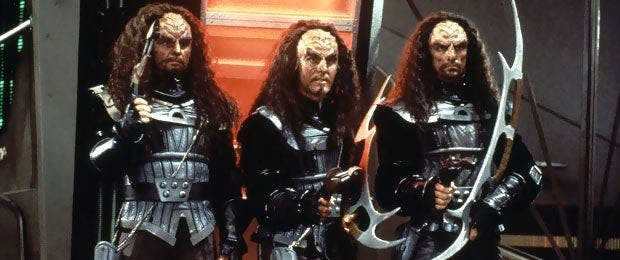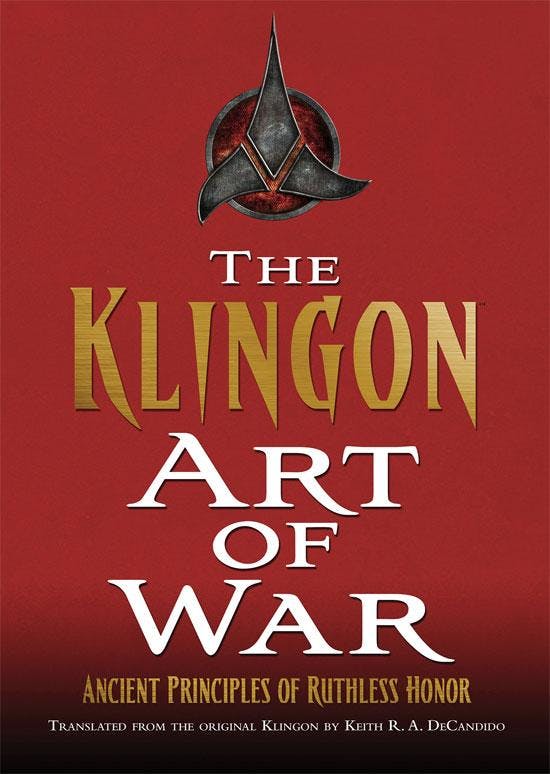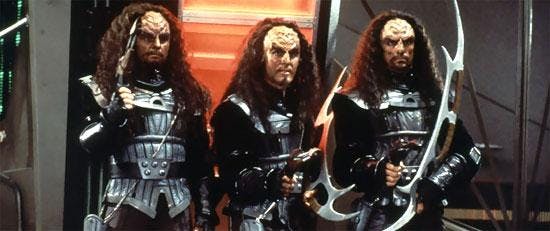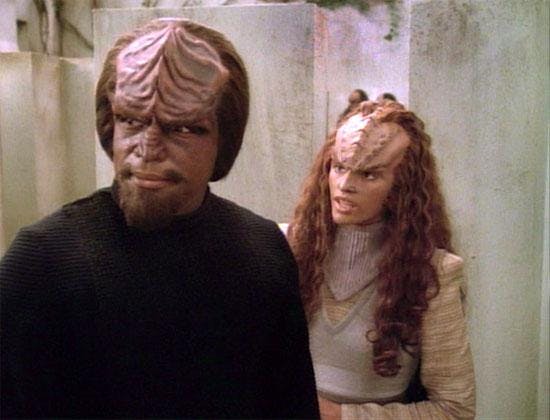Published May 5, 2014
Behind the Scenes Of The Klingon Art of War
Behind the Scenes Of The Klingon Art of War

Keith R.A. DeCandido’s latest Star Trek project, The Klingon Art of War, is far from his first dance with Klingons. The author’s love of Klingons started back when he was a kid growing up in New York City in the 1970s and he watched Star Trek reruns every night on Channel 11. He, like so many other fans, caught "Day of the Dove" and found himself completely captivated by Kang. “It was all downhill from there,” DeCandido jokes.” Michael Ansara's sheer awesomeness got me interested in Klingons, and I've had tremendous amounts of fun exploring the culture in various and sundry novels, novellas, short stories, comic books” – including Star Trek: The Next Generation: Diplomatic Implausibility, the Star Trek: IKS Gorkon books, Star Trek: Aliens: Klingons – “and, now, in The Klingon Art of War.”

StarTrek.com recently caught up with DeCandido for a detailed conversation about The Klingon Art of War, which will be released on tomorrow by Simon & Schuster/Pocket Books (via becker&mayer!). The Klingon Art of War breaks down the 10 precepts that shaped Klingon culture and indoctrinated Klingons in the Way of the Warrior dating back to the days of Kahless. Here’s what DeCandido had to say:
How did this particular project come about?
DECANDIDO: It started with John Van Citters of CBS Consumer Products, the person who approves all Trek ancillary products, and Ben Grossblatt of the book packager becker&meyer!, who put the book together. They conceived the book and came to me with the basic structure of the ten precepts, and my task was to flesh it out into a whole book. I then used my own fairly encyclopedic knowledge of Trek in general and Klingons in particular. The book takes elements from what was established on screen in all five TV series and in the movies, as well as material from prose and comics stories, not just my own of the latter, either—notably, I used stuff from both John M. Ford's seminal The Final Reflection and Michael Jan Friedman's Kahless.
In the best ways possible, The Klingon Art of War is hardcore Trek and hardcore Klingon probably even for hardcore Trek fans and diehard Klingon lovers. What were you aiming to accomplish with this book?
DECANDIDO: One of the things that Star Trek has been really good at is giving us some very nifty alien cultures that have complex philosophies that work nicely as a mirror to different aspects of humanity. Vulcans, Bajorans, Romulans, Cardassians, and Klingons in particular have really proven to be a source of endlessly fascinating cultural exploration. With The Klingon Art of War, it's an attempt to provide a philosophical base for the culture, something that's at the same time actually useful as a guide to living one's life to the fullest. I've been joking that this is my first self-help book, but it's not entirely a joke—there is, I think, some stuff here from the fictional history of Klingons that can be useful in everyday life. To that end, there's not just stories of warriors and heroes and emperors here. I made sure to try to include stories of the lives of more workaday people, of the non-warriors.

Which of the precepts did you find most interesting to write about, and how did you go about expanding them and expounding on them, in terms of building upon what fans have seen on the shows and in the films over the past nearly 50 years?
DECANDIDO: Hard to narrow that down. I think probably my favorite was the Ninth Precept, because I really enjoyed writing the story of Kahless's final confrontation with Molor, a battle that was first described in "Firstborn" on The Next Generation, and which has been established as the final battle Kahless had to win in order to unite Qo'noS. I also made a conscious decision to make sure that there were anecdotes regarding Kor, Kang, and Koloth, but also that they weren't any of the events we saw or heard described on screen. Those three lived long lives, so rather than rehash something we learned in an episode we can see on DVD any time, I came up with new adventures for all three of them.
The Klingons in TOS are vastly different from the ones in TNG, which are vastly different from the ones in... You get the idea. Worf on TNG changed dramatically from the beginning of the show to the end, and he evolved even more on DS9. Where/how did you draw the line in terms of who and what a Klingon is and represents?
DECANDIDO: The point is that there isn't a single way to be a Klingon. One of the reasons why Klingons have proven to be so vital as a species to pursue is that there is more to them. And I'd argue they didn't change as much between TOS and TNG as people like to think. Watch "Errand of Mercy" again—specifically, watch Kor. I'd argue that the Klingons of the 24th century owe plenty to how John Colicos played the role. And the diversity is what makes it interesting. In "Birthright, Part II"—one of my absolute favorite episodes—Ba'el asks Worf if the stories of Kahless are true, and Worf says he finds new truths in them every time he reads or tells them, and that's the point. There is no one way to be a Klingon, although there are basic notions that are constant.

What do you think the average human will take away perusing The Klingon Art of War?
DECANDIDO: One of the elements I brought into the book was a lot of Eastern martial arts philosophies. I'm a second-degree black belt in karate, and there are many precepts of my training that also apply to Klingon life. In particular, I remember watching "Rightful Heir," and hearing the clone of Kahless talking about the purity and joy to be taken in two people fighting each other, which is very similar to what the Shihan who runs my dojo says about our sparring classes. Just in general, there's a lot about life that is very much like combat, and there are some methods of dealing with it that are very Klingon. While a lot of this stuff is a bit extreme, the basics of it are ones that can be useful tools for getting through life, I think.
Which of the precepts do you hold most dear?
DECANDIDO: Probably "Die standing up." I've always been a proponent of the philosophy once espoused by Woody Allen: "I don't want to achieve immortality through my work, I want to achieve immortality through not dying." I think death is something to be fought against and avoided at all costs, but it's also something you're stuck with, so you may as well face it standing up.
If you could be, for one day, any Klingon from across the Trek franchise, who would you choose to be and why?
DECANDIDO: The guy who ran the Klingon restaurant on Deep Space 9.

Trek-wise and on the non-Trek front, what else are you working on at the moment?
DECANDIDO: I just turned in a tie-in novel for a property I've never worked in before. That'll be announced around the end of May. Over the course of this year, I'll have a bunch of things out, including short stories in the anthologies Bad-Ass Faeries: It's Elemental, With Great Power, and Out of Tune, an adventure in the Firefly: Echoes of War role-playing game entitled "Merciless"—that's my first RPG adventure, actually—and the next novel in my fantasy police procedure series Mermaid Precinct. I'm working on some stuff for another tie-in property I've never worked in before, as well as a couple of short stories in my original milieus—both the "Precinct" universe and my Key West-based urban fantasy universe—and some original novels I want to work on.
In the Trek world, I've got an essay coming out in the New Worlds and New Civilizations: Exploring Star Trek Comics volume from Sequart, and I'm continuing to do my rewatch of Deep Space Nine every Tuesday and Friday on Tor.com. I also continue to blog (kradical.livejournal.com), post on Facebook (facebook.com/kradec), and Tweet (@KRADeC), I do stuff for The Chronic Rift podcast, I've got my monthly Dead Kitchen Radio podcast, and I'm doing freelance editing work through my KRADitorial services. Information about all that stuff can be found on my web site at www.DeCandido.net.
The Klingon Art of War runs 160 pages and will be available in both the hardcover and eBook formats, for $25.99 and $13.99, respectively. Visit Amazon.com to pre-order. Also, now through May 6, fans can win one of 25 free copies of The Klingon Art of War in a giveaway through Goodreads (U.S. residents only). Visit goodreads.com to enter.

